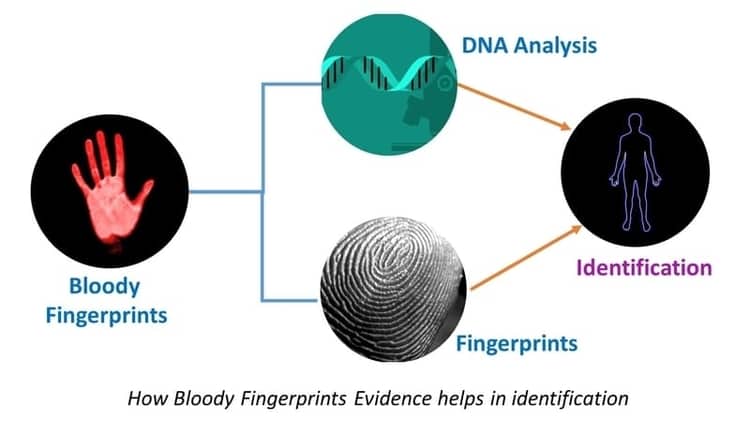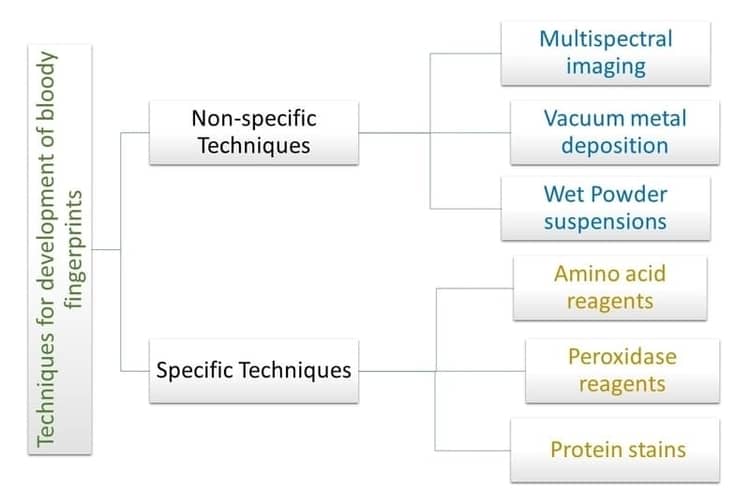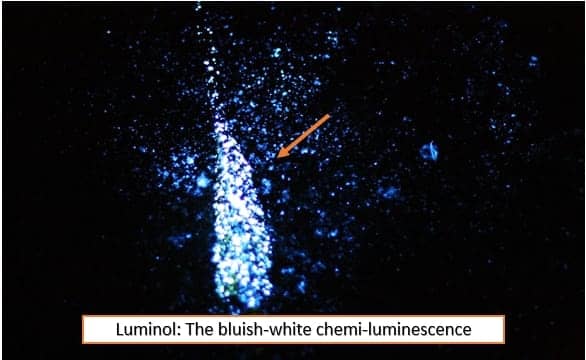Blood is one of the most common types of biological evidence that are encountered in violent crime scenes. And blood is one of the most commonly observed fingerprint contaminants. and these prints are called bloody fingerprints. The proper definition would be
It is defined as the deposition of blood on the fingermarks (or fingermarks because of blood) developed by pressing the friction ridges against the surface which finally results in a print that could be visible, plastic, and latent.
Developing blood fingerprints may depend on the type of surfaces and also the types of environmental conditions eg. rain. Depending on the type of condition we can develop fingerprints which we discuss in this blog post.
What is a Bloody Fingerprint?
A bloody fingerprint is defined as the deposition of blood on the fingermarks, which are developed by pressing the friction ridges against the surface.
It not only helps in identification by fingerprint analysis but also from DNA analysis. So, it is one of the crucial evidence that may be encountered at a crime scene.
What type of evidence is a bloody fingerprint?

As there are two elements in a blood fingerprint: Blood and finger marks then you can say that:
- A fingerprint is a physical evidence, and
- Blood is biological evidence,
- And both are direct evidence (established the fact).
So, with that, you can say that blood fingerprints are physical-biological direct evidence.
Types of Bloody Fingerprint
There are mainly three types of blood fingerprints found at a crime scene that are categorized based on physical properties:
1. Visible Bloody Fingermarks
Fingers covered by blood leave these prints on the surfaces. Print of these types is less found at the crime scene because of their visibility.
2. Plastic Bloody Fingerprint
These are also understood as negative-visible blood marks because they are formed when the surface carries the blood, not the fingers.
They are rarely seen as the pool of blood generally flushed the ridges but as the blood starts to dry the chance of getting plastic blood fingerprints increases.
3. Latent Bloody Fingerprints
These fingerprints are invisible marks, deposited with a small amount of blood on the ridges. Sometimes conditions such as rain cause washing off the blood on friction ridges.
Sensitivity vs Specificity of Developing Blood Fingerprints
The choice between sensitivity and specificity of the development process of bloody fingermarks is highly based on the state of occurrence and chemical properties (such as other contamination fluids)
So, blood fingerprints can be enhanced using a wide range of methods. And for development of bloody fingermarks depends upon the type of prints that are found at the crime scene.
And, the techniques of developing blood fingermarks usually be a sensitivity or specificity to blood.
But based on the type of case, the developing officer must choose between sensitivity and specificity way of development.
1. The sensitivity of developing blood fingermarks: Sensitivity is defined as how a substance is more prone to act on others to liberate reaction which results in any change in color and composition (not limited to).
2. The specificity of developing blood fingermarks: Specificity is the quality of a response that can be accomplished without interference from any other substance. In other words, selectivity can be used to determine how much a type of element is present in the compound.
There are many methods that are proficient in reacting with and enhancing the constituents of blood.
But the best-developing blood marks techniques serve to have the highest sensitivity and highest selectivity or specificity. It is desirable to have both properties as high as possible.
In general, highly sensitive techniques that are capable of enhancing the faintest finger ridges by reacting with multiple constituents in the blood result in lower specificity.
Highly sensitive techniques are good for the detection of faint prints but resist with a major drawback i.e. the sensitivity costs specificity and may result in a false-positive reaction by a number of other chemicals.
So, it may be necessary to use processes in combination with both visualizing faint ridges of blood and also confirm that the substance is present in the blood.
Techniques for Development of Bloody Fingerprint
The blood prints can be made visible by dusting with powders or making the fingerprints in some way more visible by using a chemical reagent.
So, bloody fingerprints can be developed by two methods:
- Physical Methods
- Chemical methods
And both these, physical methods and chemical methods are further categorized on the basis of their specificity.
Bloody latent fingermarks enhancement techniques based on the specificity:
- Non‐specific Processes
- Powder techniques
- Multispectral imaging
- Vacuum metal deposition
- Powder suspensions
- Specific Processes
- Amino acid reagents
- Protein stains
- Peroxidase reagents
- Crystal tests

Non‐Specific Bloody Fingerprint Development Techniques
1. Multispectral Imaging
A multispectral image is one instrument that captures image data for specific wavelength ranges of the electromagnetic spectrum.
As blood shows a characteristic reflectivity spectrum. Multispectral imaging has proven to be a sophisticated technique for detecting faint traces of blood.
And also estimate the time of deposition on the surface and determine the time since its deposition on the surface. (Source)
2. Vacuum Metal Deposition
Blood will form a thin layer on the surface. And blood fingermarks and surfaces have different chemical and physical properties which facilitate the film of the blood to be easily distinguished from the background during subsequent metal deposition.
Check our full detailed article on vacuum metal deposition- Click here.
3. Wet Powder Suspensions
Wet Powder suspensions preferentially deposit particles on some blood constituents, possibly proteins. (Source)
Specific Process of Development Bloody Fingerprint
Based on specificity, there are a total of two broad groups; one is amino acid reagents and the other is protein stain reagents.
A. Amino Acid Reagents
1. Ninhydrin
Ninhydrin reacts with amino acids to produce a purple reaction color product called “Rhuemann’s Purple”. The development process can be hastened by the application of heat.
And purple color is an indication of amino acids not only from sweat but from any biological fluids. This reason why they can be used in developing latent bloody fingerprints. (Source)
2. DFO (1,8-diazafluoren-9-one)
DFO can be applied to make slight bloodstains noticeable. It is generally considered more sensitive than Ninhydrin in green light (about 530 nm), it fluoresces strongly.
3. 1,2-indandione
It can be used to develop blood-fluorescent fingerprints on porous materials. The 1,2-indandione reagent reacts with amino acids irrespective to biological fluids and generates highly fluorescent fingerprint ridges.
B. Protein Stains Reagents
All these protein stains dye mainly develops prints in three basic steps, listed as;
Stage 1: Fixation of marks
The marks are fixed by applying heat, using methanol, or using an acidic fixing solution.
Stage 2: Treatment of Marks with Protein Stain Dye
The marks are then treated with a protein stain that dyes the precipitated basic proteins to give a colored product.
Stage 3: Application of a de‐staining solution
This functions by re‐dissolving and removing the excess dye that has not become bound to the proteins whilst retaining the intensity of the color of the dye in the fingermark.
Here are some examples of protein stain blood fingerprints development reagents, listed here;
Acid Black 1: It is a diazo dye that stains the proteins present in the blood to give a blue‐black color.
Acid Yellow 7: It is an amino-ketone dye that stains proteins to give a pale yellow product that fluoresces bright yellow when illuminated with blue light sources.
Acid Violet 17: It is a triarylmethane dye, which stains proteins to give a bright violet product.
C. Peroxidase Reagents
All of the peroxidase reagents used for blood enhancement of fingermarks are based on the peroxidase activity of the haem group.
Peroxidase activity can be defined as the ability to reduce hydrogen peroxide to water and oxygen.
H2O2 + colorless reduced dye → H2O + colored oxidized dye
For example: In the case of Leuco Crystal Violet and Leuco Malachite Green, the oxidation reaction results in a minor structural rearrangement producing the colored form of a blood fingerprint.
Some examples of peroxidase reagents for the development of blood fingermarks;
1. Leuco Malachite Green
On reaction with blood finger marks, the leuco malachite green reagent oxidized to form a deep green colored product (Basic Green 4). This color is due to the catalyzed reaction of the reagent with the haem group in the blood.
2. Leuco Crystal Violet
This dye is get converted from a colorless form to a purple/violet colored form on contact with blood fingermarks.
3. Diaminobenzidine
This peroxidase reagent is a derivative of benzidine and reacts with the haem molecule turning marks in the blood to a dark brown. The reaction is initiated by hydrogen peroxide. It can be used for enhancing marks in blood on both porous and non-porous surfaces.
4. Luminol
The bluish‐white chemiluminescence results from a positive reaction with blood fingerprints. The developed prints are faint and they must be viewed in a fully darkened environment.
5. Fluorescein
Fluorescein is used in another presumptive test for blood that utilizes the peroxidase activity of the haem group. It is usually applied in a two‐step process for the development of blood fingermarks:
- Yellow coloration on the application of fluorescein reagent.
- Overspray of hydrogen peroxide, to reduce the appearance of background fluorescence and false‐positive reactions.

Table: Summary of Blood Enhancement Methods based on the specificity
| Process type | Reagents | Targeted Blood constituents | Specificity to blood |
| Amino acid reagents | ninhydrin, DFO, 1,2-indandione | Amine groups in proteins, amino acids, and haem groups. | Low: False-positive result in case of protein and proteinaceous. |
| Protein stains | Acid Black 1, Acid Violet 17, Acid Yellow 7 | Proteins in plasma, haem groups and, agglutinogens | Medium: False positives include proteinaceous |
| Peroxidase reagents | Leuco Crystal Violet, Leuco Malachite Green, diaminobenzidine | Haem groups | Medium-high: False positives may include other species with peroxidase functionality such as vegetable peroxidases (e.g. horseradish), elemental iron and its oxides |
| Crystal tests | Takayama and Teichmann tests | Haem groups | High: False positives include haem groups from animal blood. |
| Antibody tests | Immunoassay test | Human Hb proteins | Very High: Specific to human. |
How to Collect Blood Fingerprints at a Crime Scene? (Procedure)
For a collection of blood fingerprints at the crime scene, there are six main steps involved, listed as:
1. Is it blood or not?
In the case of a blood fingerprint, it is crucial to define whether the fluid is blood or not. For this, a bunch of presumptive and confirmatory tests is available.
2. Is it human blood or not? (if human then DNA analysis)
After identifying it as blood, then the next question that arises is, is it human blood or not? All tests must be performed without altering the ridges of the fingermarks.
3. Initial Photography
Before developing the blood fingerprint, it is a good practice that the prints are photographed before developing blood digits. So, in case of prints are visible or partially visible or even faint are discovered. The use of alternative light should perform to amplify its visibility.
4. Developing bloody fingermarks
Before developing blood marks, one should consider two facts i.e. which type of surfaces the prints are on (Porous and Non-porous surfaces), and bloody fingerprint developing techniques (specificity vs sensitivity)
5. Photography
Before lifting, photographs of developed blood fingerprints should be captured. This is because, while lifting fingerprints, there might be a case of abruption of friction ridges.
6. Lifting & Documentation of Blood Fingerprints
The last step is to lift the blood fingerprint and specify the corresponding tags and values. Usually, lifting is done by the tape and pull method. But if the prints are too weak, try to use taping carefully and photography of the prints should always be done prior to lifting.
Case Study Related to Bloody Fingerprint
Case Study 1: Catherine Woods Killer
A young woman named Catherine woods was violently killed in her apartment, in New York, 2005.
A bloody fingerprint, from the drywall in the apartment, was developed later with the amido black reagent. The developed fingermark was matched with her boyfriend, Paul Cortez, who laterally was charged with her murder.
In court, the defense attorney used a statement from the technician that he did not see ridge detail until he applied the amido black dye reagent.
So, the latent fingerprints were exposed to accidental blood during the brutal killing of Woods. The blood reagent amido black enhanced the bloody fingermark, sequentially evidencing that the marks were deposited in blood. Thus, is a genuine bloody fingerprint.
Hungarian red is a versatile and well-known blood print enhancement chemical, one of the protein dyes. Its chemical name is acid violet 19 or fuchsin acid.
So, it belongs to the same family as Amido black or Acid yellow 7 i.e. protein staining reagent.
Case Study 2: Enhancement of Fingerprints in Diluted Blood
In the study titled Enhancement of Fingerprints in Diluted Blood by David Petretei, Hungarian Red and Amido black performed well for the development of bloody fingerprints from human skin.
On cadaver skin, both were perfect (unlike LCV). Since Amido contains methanol, it is not advisable to try it on living humans’ skin. However, Hungarian red is found to be a viable option for the development of prints even on living skin.
It is also found out that most CSI officers of Hungary prefer Hungarian red over Amido black to treat bloody prints on a crime scene. There are numerous advantages of using Hungarian red over Amido black for developing a blood fingerprint. These are, Hungarian red is:
- non-toxic.
- not flammable
- contains only fixative and dye
- no special rinsing solutions are needed (AB needs to be rinsed with methanol-based dilution, which is also toxic).
Know More: Petretei, David. Enhancement of Fingerprints in Diluted Blood. Z Zagadnien Nauk Sadowych. 120. 267-277 [ResearchGate.net]
Conclusions
The enhancement or development techniques for bloody fingerprints in situations where blood is suspected to be present can be complicated because of the problem while dealing with DNA analysis.
This is due to the fact that fingermarks with blood are not only the one elemental evidence, as other blood‐related forensic examination may need to be conducted.
Other forensic examinations include blood pattern analysis, recovery of footwear marks, and DNA analysis.
Hope you like our article on, “Development of Bloody Fingerprint“, please comment if you have any queries related to this topic, we love to hear from your side.
You May Also Like the Following articles and MCQ sets
- Presumptive Tests for Blood: 11 Important Forensic Tests Included
- Teichmann Test (Hematin) For Blood: Principle, Reagent, Procedure, Pros and Cons
- Kozelka And Hine Method of Alcohol Determination
- Offensive Vs Defensive Wounds: Forensic Injuries & Medico-Legal Importance
- Age Estimation From Teeth: All Forensic Odontology Tables Included
- How Long Do Fingerprints Stay on Clothes? A Forensic Guide

FR Author Group at ForensicReader is a team of Forensic experts and scholars having B.Sc, M.Sc, or Doctorate( Ph.D.) degrees in Forensic Science. We published on topics on fingerprints, questioned documents, forensic medicine, toxicology, physical evidence, and related case studies. Know More.
